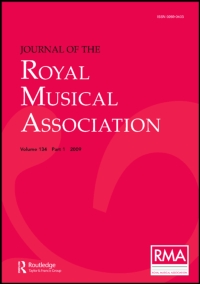No CrossRef data available.
Article contents
Irish Church Composers and the Irish Cathedrals
Published online by Cambridge University Press: 01 January 2020
Extract
I have been honoured by an invitation to contribute to your proceedings, by selecting as the subject of a paper, some account of Irish Church musicians and Irish Church music generally—a subject, hitherto, not much worked up by English musical historians between two covers. I am by no means unmindful of the admirable lecture delivered by the late Sir Robert Stewart in the Irish capital in 1863. This, however, was not confined to ecclesiastical music, but embraced Irish art generally. It will be my endeavour, in the course of the remarks I am allowed the privilege of making, to put you in possession of the most trustworthy knowledge of the subject, as far as I have been able to collect and compress it within the limited demand, which such a paper ought to make on your time and patience.
- Type
- Research Article
- Information
- Copyright
- Copyright © Royal Musical Association, 1899
References
∗ The Scriptorium of the monastic buildings.Google Scholar
∗ A more recent adaptation by John Oxenford, to words commencing, “The Lord is our good Shepherd,” follows the original Latin ones somewhat closely.Google Scholar
† Novello and Co., Ltd., 1899.Google Scholar
∗ Still retained in that Cathedral, the present Senior Cardinal being the Rev. W. H. Milman and the present Junior Cardinal the Rev. W. J. Hall. These offices are attached to the second and third stalls. The Sob-dean has the first stall. Other stalls carry with them the titles of Custos or Warden, Almoner, Succentor, Librarian, Epistolar, Gospeller, and Sacrist.Google Scholar
∗ Two years before, an equally scarce and carious book of words of anthems was printed for the use of Christ Church Cathedral, Dublin. My friend, Dr. A. H. Mann, organist of King's College, Cambridge, who possesses, I believe, every anthem book but this, and one printed by Stephen Bulkley about the same period for York, tells me that the only copy he has ever seen is in the Library of Trinity College, Dublin. Dr. Rimbault, in 1868, confessed his inability to find a copy of Bulkley's book in York Minster Library.Google Scholar
∗ Original key, E natural.Google Scholar
∗ This Service has recently been introduced at S. Michael's College, Tenbury, by the Rev. John Hampton, the present Warden and Precentor.Google Scholar
∗ The date is erroneously given in Townsend's “Calendar of Knights” as 1806, and also in a letter written to “The Orchestra,” by Sir Robert Stewart, March 4, 1867, as 1808.Google Scholar
∗ The motets and Mass music of these composers must have been in use in Sir John's time in the Roman Catholic chapels of DublinGoogle Scholar
∗ I may exempt, however, the settings of the Credo from the Services of Purcell in B flat, Blow in A, E minor, and G (triple measure). Croft in A, Hayes in E flat, Cooke in G, Arnold in B flat, Clarke-Whitfeld in C, D, E, and E flat, and several of those of Charles King. The Crucifixus est, from the last-named composer's Service in C (written on his death-bed in 1748) is extremely pleasing.Google Scholar
Attwood's five Services contain no music for the Creed, and one cannot help regretting that he never set it. No doubt he would have treated it very finely and dramatically. In his time the only portions of the Communion Service sung at S. Paul's and the Chapel Royal, at which places he officiated as organist and composer (1796–1838) were the Sanctus and Kyrie, the former as an Introit. The Creeds from Michael Wise's Services in E flat and F minor (c. 1670) by no means lack expression.Google Scholar
∗ I.e., The repetition of a phrase or passage raising the pitch of one note at each repetition. Used in descending passages, it was held to typify depression; in ascending ones, exaltation. The “Rosalia” was common to musicians in Weldon's day.Google Scholar
∗ A charming trio “Prepare, ye nymphs, prepare,” has been printed from this piece.Google Scholar
∗ His last composition was a duet for tenor and bass: “We are told that man is made of dost.”Google Scholar
∗ A most entertaining book. Soon after its publication, Miss Austin, the distinguished translator of Ranke's “Lives of the Popes,” remarked, in a letter to Dean Milman, that Moore was “one of the most interesting characters ever portrayed, and profoundly respectable withal.”Google Scholar


